Challenge
Challenge: Identify statue on Northern Ireland notes
20 02, 2016 14:30

If you can precisely identify the proper name and location of the statue above—or have a lead which you think might be useful—please send me an email, preferably including a URL which links to evidence supporting your identification. This same statue appears at center front of Northern Ireland B615 to B808.
According to Diarmuid Curran, it's a generic vignette of Hibernia. Can anyone confirm or refute this assertion?
Challenge: Identify building on back of Brazil 20,000-reais note of 1923
17 11, 2014 19:20
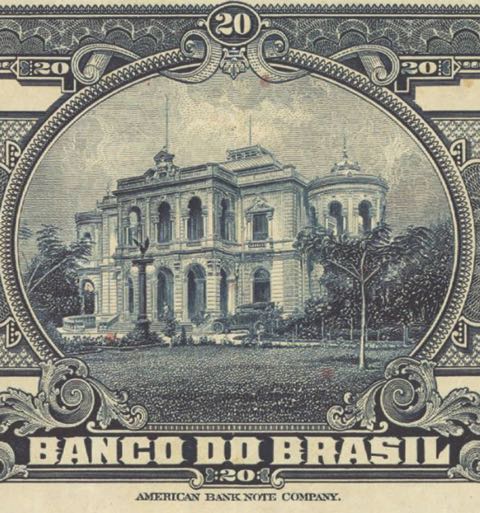
Can anyone positively identify the building on the back of the 1923-dated note P116? SCWPM lists it as Monroe Palace, but it doesn't appear to match any views of said building that I could find online.
IDENTIFIED: The Palácio da Liberdade is a building in Belo Horizonte, Brazil, which was for several years the office of the government of Minas Gerais state.
Courtesy of Wesley Stel.
The Challenge: Identify vignettes on Mozambique's notes
27 04, 2014 19:26
Today’s challenge is to identify the following vignettes from Mozambique's banknotes.
If you can precisely identify the proper name of any of the following—or have a lead which you think might be useful—please send me an email, preferably including a URL which links to evidence supporting your identification.
The following scene appears on the front of Mozambique's 100-metical note (P126) dated 16 de JUNHO DE 1980.
IDENTIFIED: Five FRELIMO soldiers raising flag on 25 June 1975 at Machava stadium in Lourenço Marques (Maputo).
Courtesy of Martin Maillot.
The following two scenes appear on the front of Mozambique's 500-metical note (P127) dated 16 de JUNHO DE 1980, so they may be related. The bottom scene could be a crowd waving their voter ID cards. However, I don't like to publish guesses in The Banknote Book, so if anyone can properly identify this vignette, please do.

IDENTIFIED: Permanent Commission seated behind Samora Moisés Machel addressing People's Assembly.
Courtesy of David Blair.

The following scene appears on the front of Mozambique's 1,000-metical note (P128) dated 16 de JUNHO DE 1980. On the wall is inscribed FRELIMO [Frente de Libertação de Moçambique] PARTIDO DE VANGUARDA DA REVOLUÇÃO SOCIALISTA, so it appears to be a monument or memorial to liberation fighters, but I've been unable to find its official name or location.

IDENTIFIED: FRELIMO monument in Maputo in a small crescent-shaped square along Avenida Samora Machel, beside the old colonial Governor’s house (so called Casa de Ferro) and before the entrance gate of the Tunduru Botanic Gardens. At some point, the monument was replaced by a statue of the FRELIMO leader Samora Moises Machel, killed in a plane crash on 19 October 1986. Courtesy of Rocco Di Leone.
The following scene appears on the front of Mozambique's 5,000-metical note (P133) dated 3 de FEVEREIRO DE 1988 and the 500-metical note (P134) dated 16 de JUNHO DE 1991. Is the statue/carving a famous one? If so, by whom, and what is the name?

IDENTIFIED: Wood sculpture by Alberto Mabungulane Chissano. Courtesy of Thomas Augustsson.
The following scene appears on the front of Mozambique's 20,000-metical note (P140) dated 16 DE JUNHO DE 1999.

IDENTIFIED: Allegorical representation of education.
Coutesy of Frank van Tiel.
The following appears on the back of Mozambique's 50,000-metical note (P138) dated 16 DE JUNHO DE 1993. Is this just decorative artwork, or does it have some other significance?

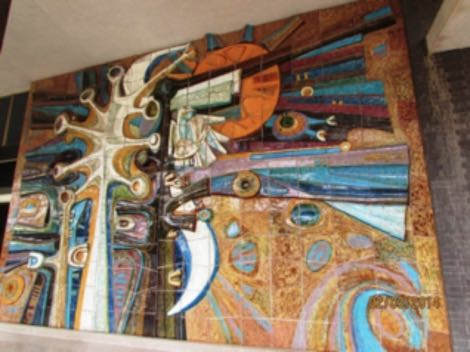
IDENTIFIED: Portion of ceramic low relief on the front of the bank headquarters by artist Querubim Lapa de Almeid. Courtesy of Rocco Di Leone.
If you can precisely identify the proper name of any of the following—or have a lead which you think might be useful—please send me an email, preferably including a URL which links to evidence supporting your identification.
The following scene appears on the front of Mozambique's 100-metical note (P126) dated 16 de JUNHO DE 1980.

IDENTIFIED: Five FRELIMO soldiers raising flag on 25 June 1975 at Machava stadium in Lourenço Marques (Maputo).
Courtesy of Martin Maillot.
The following two scenes appear on the front of Mozambique's 500-metical note (P127) dated 16 de JUNHO DE 1980, so they may be related. The bottom scene could be a crowd waving their voter ID cards. However, I don't like to publish guesses in The Banknote Book, so if anyone can properly identify this vignette, please do.

IDENTIFIED: Permanent Commission seated behind Samora Moisés Machel addressing People's Assembly.
Courtesy of David Blair.

The following scene appears on the front of Mozambique's 1,000-metical note (P128) dated 16 de JUNHO DE 1980. On the wall is inscribed FRELIMO [Frente de Libertação de Moçambique] PARTIDO DE VANGUARDA DA REVOLUÇÃO SOCIALISTA, so it appears to be a monument or memorial to liberation fighters, but I've been unable to find its official name or location.

IDENTIFIED: FRELIMO monument in Maputo in a small crescent-shaped square along Avenida Samora Machel, beside the old colonial Governor’s house (so called Casa de Ferro) and before the entrance gate of the Tunduru Botanic Gardens. At some point, the monument was replaced by a statue of the FRELIMO leader Samora Moises Machel, killed in a plane crash on 19 October 1986. Courtesy of Rocco Di Leone.
The following scene appears on the front of Mozambique's 5,000-metical note (P133) dated 3 de FEVEREIRO DE 1988 and the 500-metical note (P134) dated 16 de JUNHO DE 1991. Is the statue/carving a famous one? If so, by whom, and what is the name?

IDENTIFIED: Wood sculpture by Alberto Mabungulane Chissano. Courtesy of Thomas Augustsson.
The following scene appears on the front of Mozambique's 20,000-metical note (P140) dated 16 DE JUNHO DE 1999.

IDENTIFIED: Allegorical representation of education.
Coutesy of Frank van Tiel.
The following appears on the back of Mozambique's 50,000-metical note (P138) dated 16 DE JUNHO DE 1993. Is this just decorative artwork, or does it have some other significance?


IDENTIFIED: Portion of ceramic low relief on the front of the bank headquarters by artist Querubim Lapa de Almeid. Courtesy of Rocco Di Leone.
The Challenge: Identify items on Syrian banknotes
28 03, 2013 08:04
I am cataloging the Central Bank of Syria's notes for publication in The Banknote Book, and I have been unable to identify a few items which appear on these notes.
The back of the 100-pound note dated 1966-1974 depicts a dam. What's the name and location of this dam?

The front of the 5-pound note dated 1977-1991 depicts a female statue.


IDENTIFIED: Allāt-Minerva. Statue of the 2nd century AD from As-Suwayda, Syria (Roman province). National Museum of Damascus.
The front of the 50-pound note dated 1977-1991 depicts a female statue.


IDENTIFIED: Statue of goddess found in Sumerian ruins in Mari, Syria, now in National Museum of Aleppo.
The back of the 500-pound note dated 1958-1992 depicts something described as an ancient religious wheel.

IDENTIFIED: Gold bowl decorated with hunting/animal scenes from the Temple of Baal at Ugarit, now in National Museum in Aleppo.
If anyone has information or leads which may be helpful, please contact me with details.
Courtesy of Yaqoob Alshaer and Murray Hanewich.
The back of the 100-pound note dated 1966-1974 depicts a dam. What's the name and location of this dam?

The front of the 5-pound note dated 1977-1991 depicts a female statue.


IDENTIFIED: Allāt-Minerva. Statue of the 2nd century AD from As-Suwayda, Syria (Roman province). National Museum of Damascus.
The front of the 50-pound note dated 1977-1991 depicts a female statue.


IDENTIFIED: Statue of goddess found in Sumerian ruins in Mari, Syria, now in National Museum of Aleppo.
The back of the 500-pound note dated 1958-1992 depicts something described as an ancient religious wheel.

IDENTIFIED: Gold bowl decorated with hunting/animal scenes from the Temple of Baal at Ugarit, now in National Museum in Aleppo.
If anyone has information or leads which may be helpful, please contact me with details.
Courtesy of Yaqoob Alshaer and Murray Hanewich.
The Challenge: Identify artifacts on Lebanon banknotes
08 11, 2012 10:14
I am cataloging the Bank of Lebanon's notes for publication in The Banknote Book, and I have been unable to identify a few items which appear on these notes.
The front of the 1-livre notes (BDL B1/P61) dated 1964-1980 depict the ruins of Corinthian columns of the Roman Temple of Jupiter in Baalbek. However, I can't find any info on the unknown archeological artifact shown below.

The front of the 5-livre notes (BDL B2/P62) dated 1964-1986 depict the National Museum of Beirut building with columns. However, I can't find any info on the kneeling bull sculpture, figure with raised arm standing on coin, nor the meaning or language of the writing in the border.

IDENTIFIED: The bull is a protome from the Aecheminid Dynasty (5th Century BC) found in Sidon, Lebanon.
IDENTIFIED: The writing in the margins look to be Phoenician, though the meaning and source of the inscription is still unclear.
IDENTIFIED: The figure is Baal with raised arm standing on 400-330 BC Phoenician 1/8th shekel silver coin from the City of Byblos, King Adramelek.
If anyone knows what these objects are, please contact me with details.
Courtesy of Petar II Blagojevic, Robin Hughes, Don Cleveland, and Abdullah Beydoun.
The front of the 1-livre notes (BDL B1/P61) dated 1964-1980 depict the ruins of Corinthian columns of the Roman Temple of Jupiter in Baalbek. However, I can't find any info on the unknown archeological artifact shown below.

The front of the 5-livre notes (BDL B2/P62) dated 1964-1986 depict the National Museum of Beirut building with columns. However, I can't find any info on the kneeling bull sculpture, figure with raised arm standing on coin, nor the meaning or language of the writing in the border.

IDENTIFIED: The bull is a protome from the Aecheminid Dynasty (5th Century BC) found in Sidon, Lebanon.
IDENTIFIED: The writing in the margins look to be Phoenician, though the meaning and source of the inscription is still unclear.
IDENTIFIED: The figure is Baal with raised arm standing on 400-330 BC Phoenician 1/8th shekel silver coin from the City of Byblos, King Adramelek.
If anyone knows what these objects are, please contact me with details.
Courtesy of Petar II Blagojevic, Robin Hughes, Don Cleveland, and Abdullah Beydoun.
The Challenge: Who is Sister Sarah on Bahamas 50-cent note?
03 11, 2012 15:42

Beginning with the Bahamas' 50-cent note (P42) introduced in 1984, the back has depicted "Sister Sarah in Nassau Market." However, the bank's web site makes no mention of who this woman is, or why she is featured on the banknote. If anyone knows if she is in fact a real person, an archetype, or a fictional character, please contact me with details.
IDENTIFIED: According to Paul Walters, "Sister Sarah is indeed a real person. I am not sure if she is still living, I don't think she is. She was a prominant figure at the straw market in the 1970s, when the market was located along the dock--before it moved to its present day location on Bay street."
Alex Zlotin found this article that refers to Sister Sarah Johnson as a local artisan straw weaver.
The Challenge: Identify items on Mozambique 1975 notes
02 07, 2012 11:16
It's been a while since I last posted a challenge, but I'm working on the Mozambique chapter of The Banknote Book and I came across the following unidentified items on the banknotes dated 1975.

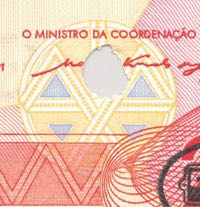
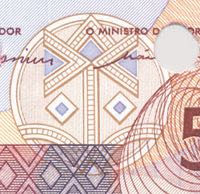

All four of these circular items appear at right front on these notes. Does anyone know what they are, or what they are supposed to symbolize?
If you can precisely identify the name of these items—or have a lead which you think might be useful—please post a comment, preferably including a URL which links to evidence supporting your identification.
Also, according to the SCWPM, these notes (Pick 120-124) were unadopted designs, but I have a scan of a well-worn 100-metical note with normal serial numbers, indicating actual circulation. So, were they issued, and if so, when, and for how long?




All four of these circular items appear at right front on these notes. Does anyone know what they are, or what they are supposed to symbolize?
If you can precisely identify the name of these items—or have a lead which you think might be useful—please post a comment, preferably including a URL which links to evidence supporting your identification.
Also, according to the SCWPM, these notes (Pick 120-124) were unadopted designs, but I have a scan of a well-worn 100-metical note with normal serial numbers, indicating actual circulation. So, were they issued, and if so, when, and for how long?
The Challenge: Identify flowers and scene on back of Suriname's 1986-1988 notes
06 12, 2011 08:50
Today’s challenge is to identify the flowers and the scene which appears on the back of the Suriname’s banknotes from 1986 and 1988 (P130-P135).
The front of these notes features a portrait of Anton de Kom, a Surinamese resistance fighter and anti-colonialist author, so it may be that the crowd scene on the back is related, but I’ve been unable to locate any information to confirm this hunch.
I’m also interested in learning the precise names of the flowers which appear behind the toucan on the back of these notes.
If you can precisely identify the flowers or scene—or have a lead which you think might be useful—please post a comment, preferably including a URL which links to evidence supporting your identification.


IDENTIFIED: Hibiscus, heliconia, and ginger flowers.
Courtesy of Frederick Martin.
The front of these notes features a portrait of Anton de Kom, a Surinamese resistance fighter and anti-colonialist author, so it may be that the crowd scene on the back is related, but I’ve been unable to locate any information to confirm this hunch.
I’m also interested in learning the precise names of the flowers which appear behind the toucan on the back of these notes.
If you can precisely identify the flowers or scene—or have a lead which you think might be useful—please post a comment, preferably including a URL which links to evidence supporting your identification.


IDENTIFIED: Hibiscus, heliconia, and ginger flowers.
Courtesy of Frederick Martin.
The Challenge: Identify building and monument on back of Madagascar 5,000-franc note
10 11, 2011 09:26
Today’s challenge is to identify the objects which appears on the back of the old 5,000-franc note of Madagascar.
If you can precisely identify the name and location of the building and/or monument—or have a lead which you think might be useful—please post a comment, preferably including a URL which links to evidence supporting your identification.
These objects appear on the back of the 5,000-franc from 1983 (Pick 69). The SCWPM claims the building is a school, but doesn’t give a precise identification. The monument has writing on it which reads “MADAGASIKARA MAHALEOTENA NAMBARA AMBAHBENASO 26 JUIN 1960.” The date is Madagascar’s independence day, and the text is in Malagasy.


IDENTIFIED: La Bibliothèque Nationale de Madagascar (The National Library of Madagascar) building in Antananarivo and Stèle de l’Indépendance in Place de l’Indépendance in Antananarivo.
Courtesy of Robert Bethea, Murray Hanewich, and Dominique Dannery.
If you can precisely identify the name and location of the building and/or monument—or have a lead which you think might be useful—please post a comment, preferably including a URL which links to evidence supporting your identification.
These objects appear on the back of the 5,000-franc from 1983 (Pick 69). The SCWPM claims the building is a school, but doesn’t give a precise identification. The monument has writing on it which reads “MADAGASIKARA MAHALEOTENA NAMBARA AMBAHBENASO 26 JUIN 1960.” The date is Madagascar’s independence day, and the text is in Malagasy.


IDENTIFIED: La Bibliothèque Nationale de Madagascar (The National Library of Madagascar) building in Antananarivo and Stèle de l’Indépendance in Place de l’Indépendance in Antananarivo.
Courtesy of Robert Bethea, Murray Hanewich, and Dominique Dannery.
The Challenge: Identify dam on front of Congo 100-franc note
05 11, 2011 09:56
Today’s challenge is to identify the dam which appears on the front of the old 100-franc note of Congo Democratic Republic.
If you can precisely identify the name and location of this dam—or have a lead which you think might be useful—please post a comment, preferably including a URL which links to evidence supporting your identification.
This dam appears on the front of the 100-franc from 1963 (Pick 1):

IDENTIFIED: Ruzizi I hydroelectric dam on Ruzizi River between Congo and Rwanda.
For extra credit, please supply the precise name of this equipment which appears on the back of this note:

IDENTIFIED: Bucket chain excavator.
Courtesy of Frederick Martin.
If you can precisely identify the name and location of this dam—or have a lead which you think might be useful—please post a comment, preferably including a URL which links to evidence supporting your identification.
This dam appears on the front of the 100-franc from 1963 (Pick 1):

IDENTIFIED: Ruzizi I hydroelectric dam on Ruzizi River between Congo and Rwanda.
For extra credit, please supply the precise name of this equipment which appears on the back of this note:

IDENTIFIED: Bucket chain excavator.
Courtesy of Frederick Martin.
The Challenge: Identify building on back of Laos 20-kip note
28 10, 2011 08:29
Today’s challenge is to identify the building which appears on the back of the old 20-kip note of Laos.
If you can precisely identify the name and location of this building—or have a lead which you think might be useful—please post a comment, preferably including a URL which links to evidence supporting your identification.
This building appears on the back of the 20-kip notes from 1963 (Pick 11):

IDENTIFIED: Wat Sop monastery in Luang Prabang.
Courtesy of José Fabrício Macêdo.
If you can precisely identify the name and location of this building—or have a lead which you think might be useful—please post a comment, preferably including a URL which links to evidence supporting your identification.
This building appears on the back of the 20-kip notes from 1963 (Pick 11):

IDENTIFIED: Wat Sop monastery in Luang Prabang.
Courtesy of José Fabrício Macêdo.
The Challenge: Identify gate on front of South Korea 100-won note of 1950
03 09, 2011 17:15
Today’s challenge is to identify the gate which appear on the front of the old 100-won notes of South Korea.
If you can precisely identify the name and location of this gate—or have a lead which you think might be useful—please post a comment, preferably including a URL which links to evidence supporting your identification.
The following image appears on the front of the 100-won note of South Korea from 1950 (Pick 7):

IDENTIFIED: Gwanghwamun gate to Gyeongbokgung palace in Seoul.
Courtesy of José Fabrício Macêdo.
If you can precisely identify the name and location of this gate—or have a lead which you think might be useful—please post a comment, preferably including a URL which links to evidence supporting your identification.
The following image appears on the front of the 100-won note of South Korea from 1950 (Pick 7):

IDENTIFIED: Gwanghwamun gate to Gyeongbokgung palace in Seoul.
Courtesy of José Fabrício Macêdo.
The Challenge: Identify items on back of Jordan 5-dinar note
29 08, 2011 07:39
Today’s challenge is to identify the items which appear on the back of the old 5-dinar notes of Jordan.
If you can precisely identify the name of these items—or have a lead which you think might be useful—please post a comment, preferably including a URL which links to evidence supporting your identification.
At left is a registration device that looks like an urn, vase, or maybe even the top of a chess piece, and at right are plants that look like cattails. These appear on the back of all 5-dinar notes from 1992 to 1997 (Pick 25 and Pick 30):
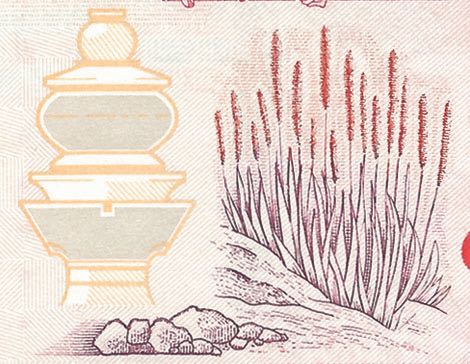
IDENTIFIED: Monastery tomb urn on top of Ed-Deir Monastery in Petra. See also this photo.
IDENTIFED: Cattails.
Courtesy of Tristan Williams and Alessio Amato.
If you can precisely identify the name of these items—or have a lead which you think might be useful—please post a comment, preferably including a URL which links to evidence supporting your identification.
At left is a registration device that looks like an urn, vase, or maybe even the top of a chess piece, and at right are plants that look like cattails. These appear on the back of all 5-dinar notes from 1992 to 1997 (Pick 25 and Pick 30):

IDENTIFIED: Monastery tomb urn on top of Ed-Deir Monastery in Petra. See also this photo.
IDENTIFED: Cattails.
Courtesy of Tristan Williams and Alessio Amato.
The Challenge: Identify building on back of Ghana's 20,000-cedi note
15 08, 2011 21:46
Today’s challenge is to identify the building which appears on the back of the old 20,000-cedi note of Ghana.
If you can precisely identify the name and location of this building—or have a lead which you think might be useful—please post a comment, preferably including a URL which links to evidence supporting your identification.
This building appears on the back of all of the 20,000-cedi notes from 2002-2006 (Pick 36):

IDENTIFIED: National Theatre of Ghana in Accra.
Courtesy of Frederick Martin.
If you can precisely identify the name and location of this building—or have a lead which you think might be useful—please post a comment, preferably including a URL which links to evidence supporting your identification.
This building appears on the back of all of the 20,000-cedi notes from 2002-2006 (Pick 36):

IDENTIFIED: National Theatre of Ghana in Accra.
Courtesy of Frederick Martin.
The Challenge: Identify objects in Liberia bank seal
18 07, 2011 08:43
Today’s challenge is to identify the crossed objects which appear in the seal of the Central Bank of Liberia (and previously the National Bank of Liberia).
If you can precisely identify the name of these objects—or have a lead which you think might be useful—please post a comment, preferably including a URL which links to evidence supporting your identification.
This bank seal appears on the back of all of Liberia’s notes since 1989:

IDENTIFIED: Kissi money.
If you can precisely identify the name of these objects—or have a lead which you think might be useful—please post a comment, preferably including a URL which links to evidence supporting your identification.
This bank seal appears on the back of all of Liberia’s notes since 1989:

IDENTIFIED: Kissi money.
The Challenge: Identify man in watermark on Mauritania's notes
15 07, 2011 17:49
Today’s challenge is to identify the following man whose face appears as the watermark on all of Mauritania’s notes since 1974.
If you can precisely identify the name of this man—or have a lead which you think might be useful—please post a comment, preferably including a URL which links to evidence supporting your identification.
This man’s face appears as the watermark on all of Mauritania’s notes since 1974, and is shown here from an unissued specimen design of 1981:

If you can precisely identify the name of this man—or have a lead which you think might be useful—please post a comment, preferably including a URL which links to evidence supporting your identification.
This man’s face appears as the watermark on all of Mauritania’s notes since 1974, and is shown here from an unissued specimen design of 1981:

The Challenge: Identify flora on Lesotho's banknotes
07 07, 2011 09:35
Today’s challenge is to identify the following plants and flowers from Lesotho’s banknotes.
If you can precisely identify the proper name of any of the following—or have a lead which you think might be useful—please post a comment, preferably including a URL which links to evidence supporting your identification.
This plant appears as the registration device on Lesotho’s 20-loti note dated 1990 (P12):
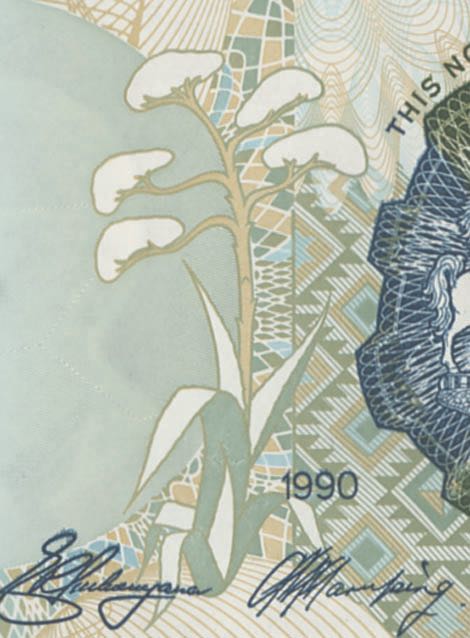
IDENTIFIED: Agave plant and flowers.
This left and flowers appear as the registration device on Lesotho’s 100-loti note dated 2001 (P19):

IDENTIFIED: Calla lily (Zantedeschia aethiopica) leaf and flowers.
This plant appears as the registration device on Lesotho’s 200-loti note dated 1994 (P20):

These flowers appear on the back of Lesotho’s 10-loti note dated 2010 (PNL):

IDENTIFIED: Cosmos flowers.
If you can precisely identify the proper name of any of the following—or have a lead which you think might be useful—please post a comment, preferably including a URL which links to evidence supporting your identification.
This plant appears as the registration device on Lesotho’s 20-loti note dated 1990 (P12):

IDENTIFIED: Agave plant and flowers.
This left and flowers appear as the registration device on Lesotho’s 100-loti note dated 2001 (P19):

IDENTIFIED: Calla lily (Zantedeschia aethiopica) leaf and flowers.
This plant appears as the registration device on Lesotho’s 200-loti note dated 1994 (P20):

These flowers appear on the back of Lesotho’s 10-loti note dated 2010 (PNL):

IDENTIFIED: Cosmos flowers.
The Challenge: Identify person on Chile's banknotes
06 07, 2011 15:24
Today I’m inaugurating a new feature on BanknoteNews.com: The Challenge.
Anyone who has downloaded chapters of The Banknote Book catalog knows that I take pains to precisely identify all the people, places, and objects depicted on banknotes. However, sometimes precise identifications remain elusive despite all the efforts of myself and various contributors. This frustrates me both as an author and a collector because it’s my belief that if a country has chosen to feature something on one of its notes, it must have some particular historical or cultural significance and it deserves better than a generic description.
So I’m turning to the power of crowdsourcing with The Challenge, an open call for help in identifying certain design elements which have heretofore defied identification.
If you can precisely identify the proper name and location of any of the following—or have a lead which you think might be useful—please post a comment, preferably including a URL which links to evidence supporting your identification.
Today’s second challenge is to identify the following person from the front of Chile’s 1-peso note dated 1898 (P15 show below, but the same also appears on P1 and P11):

The SCWPM identifies this portrait as “Prat” (presumably naval officer Agustín Arturo Prat Chacón), but this identification is called into question in this document written by collector Raúl Donoso Rosso.
IDENTIFIED: Chilean president, Federico Errázuriz Zañartu.
Courtesy of Art Matz (LANSA) and Raúl Donoso Rosso.
Anyone who has downloaded chapters of The Banknote Book catalog knows that I take pains to precisely identify all the people, places, and objects depicted on banknotes. However, sometimes precise identifications remain elusive despite all the efforts of myself and various contributors. This frustrates me both as an author and a collector because it’s my belief that if a country has chosen to feature something on one of its notes, it must have some particular historical or cultural significance and it deserves better than a generic description.
So I’m turning to the power of crowdsourcing with The Challenge, an open call for help in identifying certain design elements which have heretofore defied identification.
If you can precisely identify the proper name and location of any of the following—or have a lead which you think might be useful—please post a comment, preferably including a URL which links to evidence supporting your identification.
Today’s second challenge is to identify the following person from the front of Chile’s 1-peso note dated 1898 (P15 show below, but the same also appears on P1 and P11):

The SCWPM identifies this portrait as “Prat” (presumably naval officer Agustín Arturo Prat Chacón), but this identification is called into question in this document written by collector Raúl Donoso Rosso.
IDENTIFIED: Chilean president, Federico Errázuriz Zañartu.
Courtesy of Art Matz (LANSA) and Raúl Donoso Rosso.
The Challenge: Identify buildings and dams on Mali's banknotes
06 07, 2011 07:38
Today I’m inaugurating a new feature on BanknoteNews.com: The Challenge.
Anyone who has downloaded chapters of The Banknote Book catalog knows that I take pains to precisely identify all the people, places, and objects depicted on banknotes. However, sometimes precise identifications remain elusive despite all the efforts of myself and various contributors. This frustrates me both as an author and a collector because it’s my belief that if a country has chosen to feature something on one of its notes, it must have some particular historical or cultural significance and it deserves better than a generic description.
So I’m turning to the power of crowdsourcing with The Challenge, an open call for help in identifying certain design elements which have heretofore defied identification.
If you can precisely identify the proper name and location of any of the following—or have a lead which you think might be useful—please post a comment, preferably including a URL which links to evidence supporting your identification.
Today’s challenge is to identify the following items from Mali’s banknotes.
The building on the back of Mali’s 5,000-franc note dated 1960 (P5 shown below, but it also appears on P10):
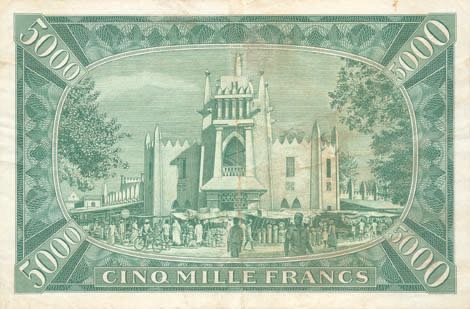
IDENTIFIED: Le Marché Rose (pink market) building in Bamako.
The dam on the front of Mail’s 50-franc note dated 1960 (P6):
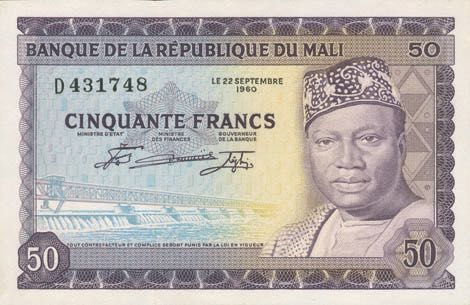
IDENTIFIED: Markala dam on the Niger River.
The dam on the front of Mail’s 1,000-franc note of 1970 (P13):
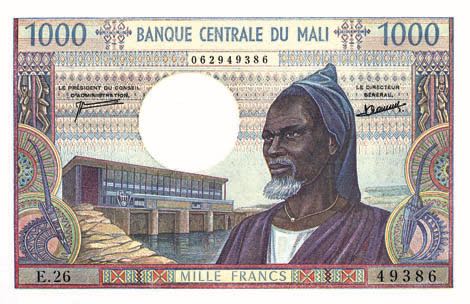
IDENTIFIED: Sotuba dam hydropower plant on the Niger River.
Anyone who has downloaded chapters of The Banknote Book catalog knows that I take pains to precisely identify all the people, places, and objects depicted on banknotes. However, sometimes precise identifications remain elusive despite all the efforts of myself and various contributors. This frustrates me both as an author and a collector because it’s my belief that if a country has chosen to feature something on one of its notes, it must have some particular historical or cultural significance and it deserves better than a generic description.
So I’m turning to the power of crowdsourcing with The Challenge, an open call for help in identifying certain design elements which have heretofore defied identification.
If you can precisely identify the proper name and location of any of the following—or have a lead which you think might be useful—please post a comment, preferably including a URL which links to evidence supporting your identification.
Today’s challenge is to identify the following items from Mali’s banknotes.
The building on the back of Mali’s 5,000-franc note dated 1960 (P5 shown below, but it also appears on P10):

IDENTIFIED: Le Marché Rose (pink market) building in Bamako.
The dam on the front of Mail’s 50-franc note dated 1960 (P6):

IDENTIFIED: Markala dam on the Niger River.
The dam on the front of Mail’s 1,000-franc note of 1970 (P13):

IDENTIFIED: Sotuba dam hydropower plant on the Niger River.
The Challenge: Iranian/Persian symbolism help sought
06 12, 2010 12:53

I’m working on the Iranian chapter of The Banknote Book and have come across this interesting engraving on the front of Pick 30, the 1,000-rial note of 1934. The image—described in SCWPM as “warrior killing fabulous creature”—also appears on the date stamps of subsequent issues. I suspect it depicts some Persian legend or myth. If anyone can direct me towards a full explanation, hopefully identifying the warrior and/or creature by name, I would appreciate it. Thanks in advance!
IDENTIFIED: Darius the Great stabbing Ahriman monster from stone relief at Persepolis.
Courtesy of Raphael.
The Challenge: Identify items on Kenyan notes
16 03, 2010 10:04

Can someone please identify the building on the back of Pick 24? Given the diploma and students in the vignette, it’s almost certainly a university, but which one? Educated guesses are welcome, but I am looking for definitive answers supported by citations if possible.
IDENTIFIED: Kabarnet Boys High School administration building in Baringo County.
Courtesy of Dennis Mukuba,
The Challenge: Identify buildings on Uganda P29 note
16 03, 2010 10:03
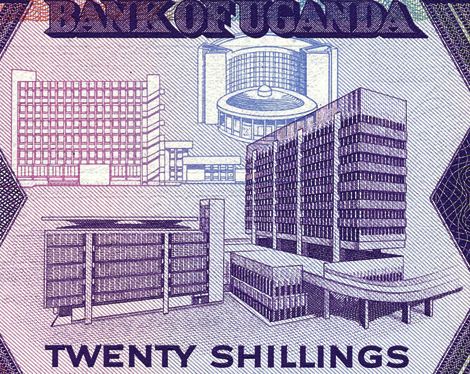
Please post a comment or send me an email if you can positively identify any of the buildings on the back of Uganda Pick 29 above.
Upper left: Unknown.
Upper center: Unknown.
Lower right: New Bank of Uganda headquarters.
Lower left: Old Bank of Uganda headquarters.
The Challenge: Identify Sudan note elements
15 03, 2010 10:08
Can anyone positively identify the following items that appear on some Sudanese banknotes? Precise names and locations of the buildings are appreciated, and links to supporting evidence is welcome, too.

1. The secretary bird at the center of this vignette appears on the front of B312 - B321. It is not the coat of arms of the country. Perhaps it is the logo of the bank?
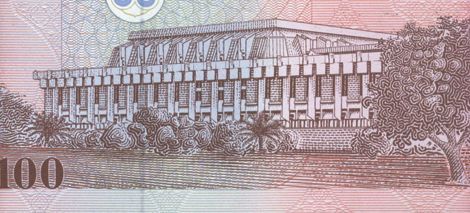
2. Identified: Parliament House in Omdurman.

3. This building appears on the back of B342 - B344. Identified by Pavel Gusev: Ministry of Information and Communications in Khartoum.

1. The secretary bird at the center of this vignette appears on the front of B312 - B321. It is not the coat of arms of the country. Perhaps it is the logo of the bank?

2. Identified: Parliament House in Omdurman.

3. This building appears on the back of B342 - B344. Identified by Pavel Gusev: Ministry of Information and Communications in Khartoum.
The Challenge: Identify Zaire and Congo DR note elements
09 03, 2010 11:43
Thanks to everyone who helped positively identify the following features which appear on the back of some banknotes from Zaire and the Congo Democratic Republic.
I find it curious that many countries are proud enough to feature certain places, people, and objects on their notes, yet they fail to label these vignettes. As a result, it’s possible that their significance may be lost on future generations. That’s why I strive to provide detailed identifications of all elements depicted on notes in my new catalog. If you enjoyed the detective work as much as I did, keep your eyes on this site for future hunts.

1. Identified: Inga I dam on Congo River.

2. Identified: Palais de la Nation in Kinshasa.

3. Identified: Palais Du Peuple in Kinshasa.
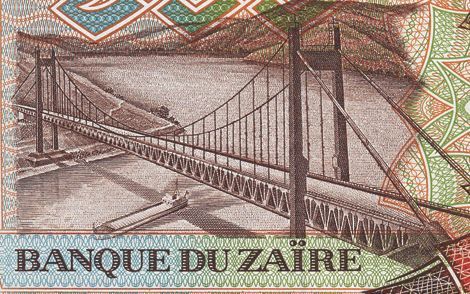
4. Identified: OEBK (Organization Équipage Banana-Kinshasa) suspension bridge (also known as Pont Maréchal) over the Congo River at port Matadi.
I find it curious that many countries are proud enough to feature certain places, people, and objects on their notes, yet they fail to label these vignettes. As a result, it’s possible that their significance may be lost on future generations. That’s why I strive to provide detailed identifications of all elements depicted on notes in my new catalog. If you enjoyed the detective work as much as I did, keep your eyes on this site for future hunts.

1. Identified: Inga I dam on Congo River.

2. Identified: Palais de la Nation in Kinshasa.

3. Identified: Palais Du Peuple in Kinshasa.

4. Identified: OEBK (Organization Équipage Banana-Kinshasa) suspension bridge (also known as Pont Maréchal) over the Congo River at port Matadi.

